MGMT1101 Leadership Management Profile: A Comprehensive Report
VerifiedAdded on 2023/01/05
|10
|2322
|46
Report
AI Summary
This report provides a comprehensive analysis of leadership, exploring trait theory, situational leadership, transformational leadership, and servant leadership. The student identifies and evaluates their own leadership traits, highlighting strengths such as emotional maturity and self-confidence, while acknowledging areas for improvement like creativity. The report defines and differentiates between situational, transformational, and servant leadership styles, arguing for the effectiveness of transformational leadership. It presents scenarios applying different leadership approaches, and the student outlines their personal leadership profile as a future manager, emphasizing the use of situational leadership and the alignment of individual and organizational goals. The report also discusses the relevance of both trait and transformational leadership theories, and includes a list of references to support the analysis.
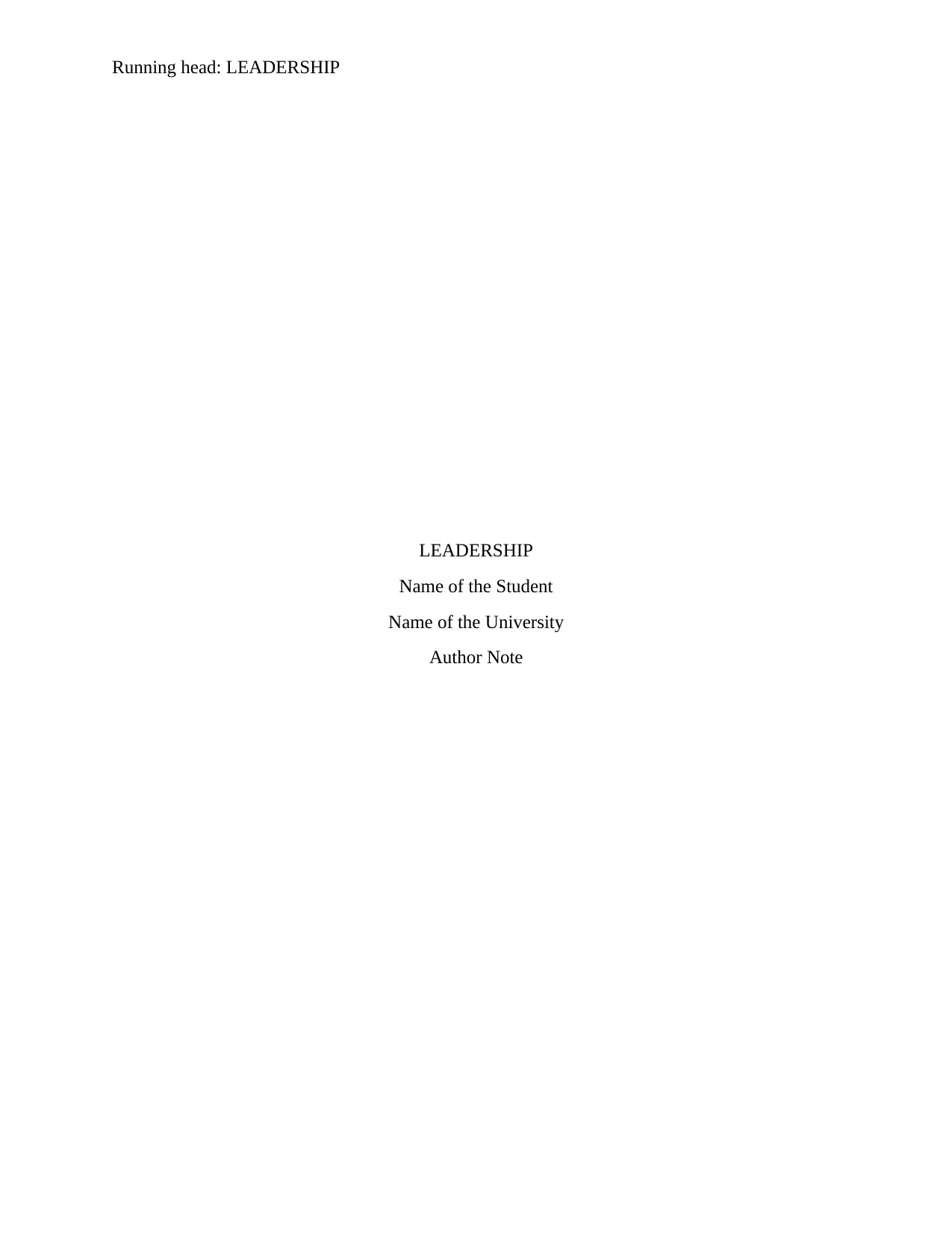
Running head: LEADERSHIP
LEADERSHIP
Name of the Student
Name of the University
Author Note
LEADERSHIP
Name of the Student
Name of the University
Author Note
Paraphrase This Document
Need a fresh take? Get an instant paraphrase of this document with our AI Paraphraser
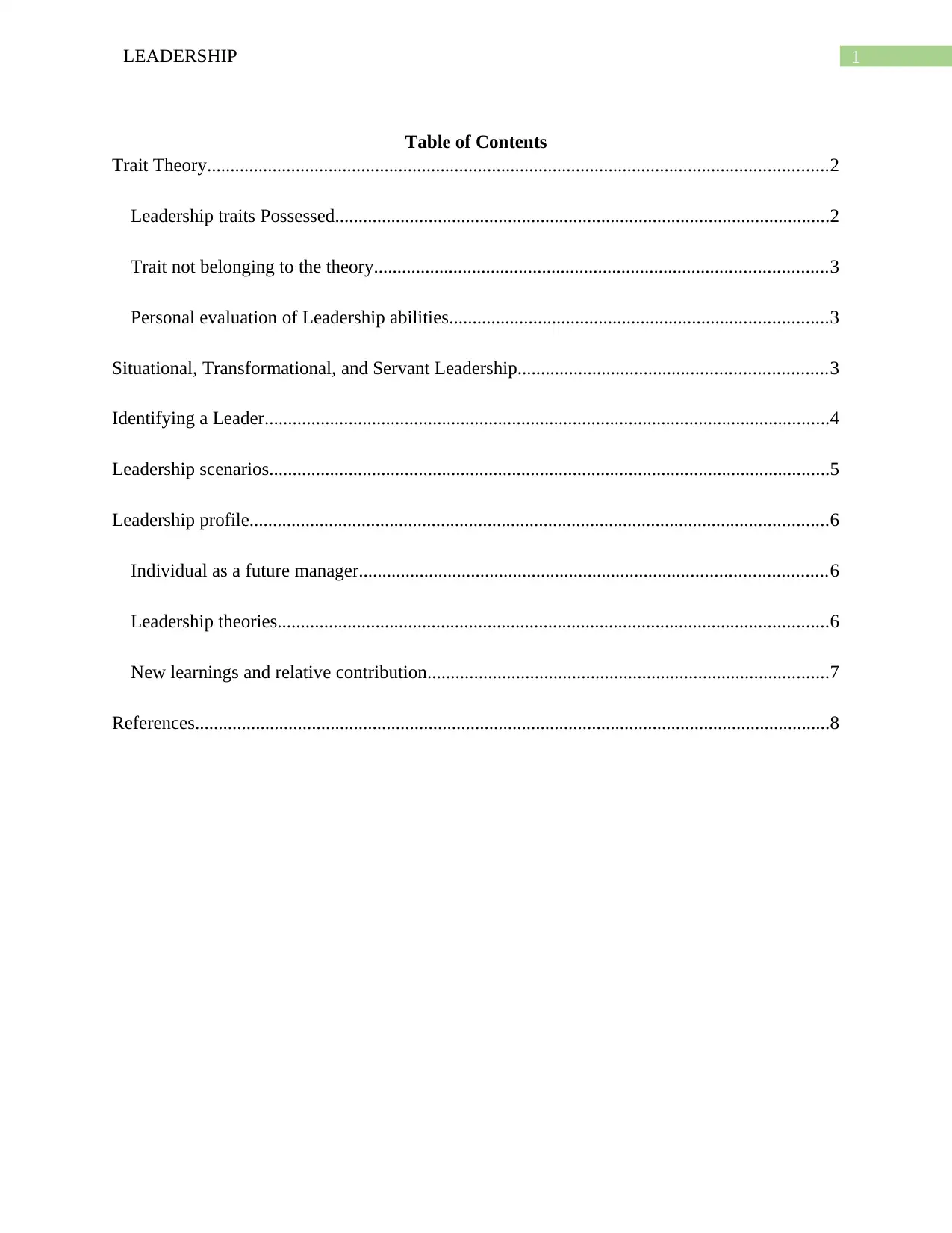
1LEADERSHIP
Table of Contents
Trait Theory.....................................................................................................................................2
Leadership traits Possessed..........................................................................................................2
Trait not belonging to the theory.................................................................................................3
Personal evaluation of Leadership abilities.................................................................................3
Situational, Transformational, and Servant Leadership..................................................................3
Identifying a Leader.........................................................................................................................4
Leadership scenarios........................................................................................................................5
Leadership profile............................................................................................................................6
Individual as a future manager....................................................................................................6
Leadership theories......................................................................................................................6
New learnings and relative contribution......................................................................................7
References........................................................................................................................................8
Table of Contents
Trait Theory.....................................................................................................................................2
Leadership traits Possessed..........................................................................................................2
Trait not belonging to the theory.................................................................................................3
Personal evaluation of Leadership abilities.................................................................................3
Situational, Transformational, and Servant Leadership..................................................................3
Identifying a Leader.........................................................................................................................4
Leadership scenarios........................................................................................................................5
Leadership profile............................................................................................................................6
Individual as a future manager....................................................................................................6
Leadership theories......................................................................................................................6
New learnings and relative contribution......................................................................................7
References........................................................................................................................................8
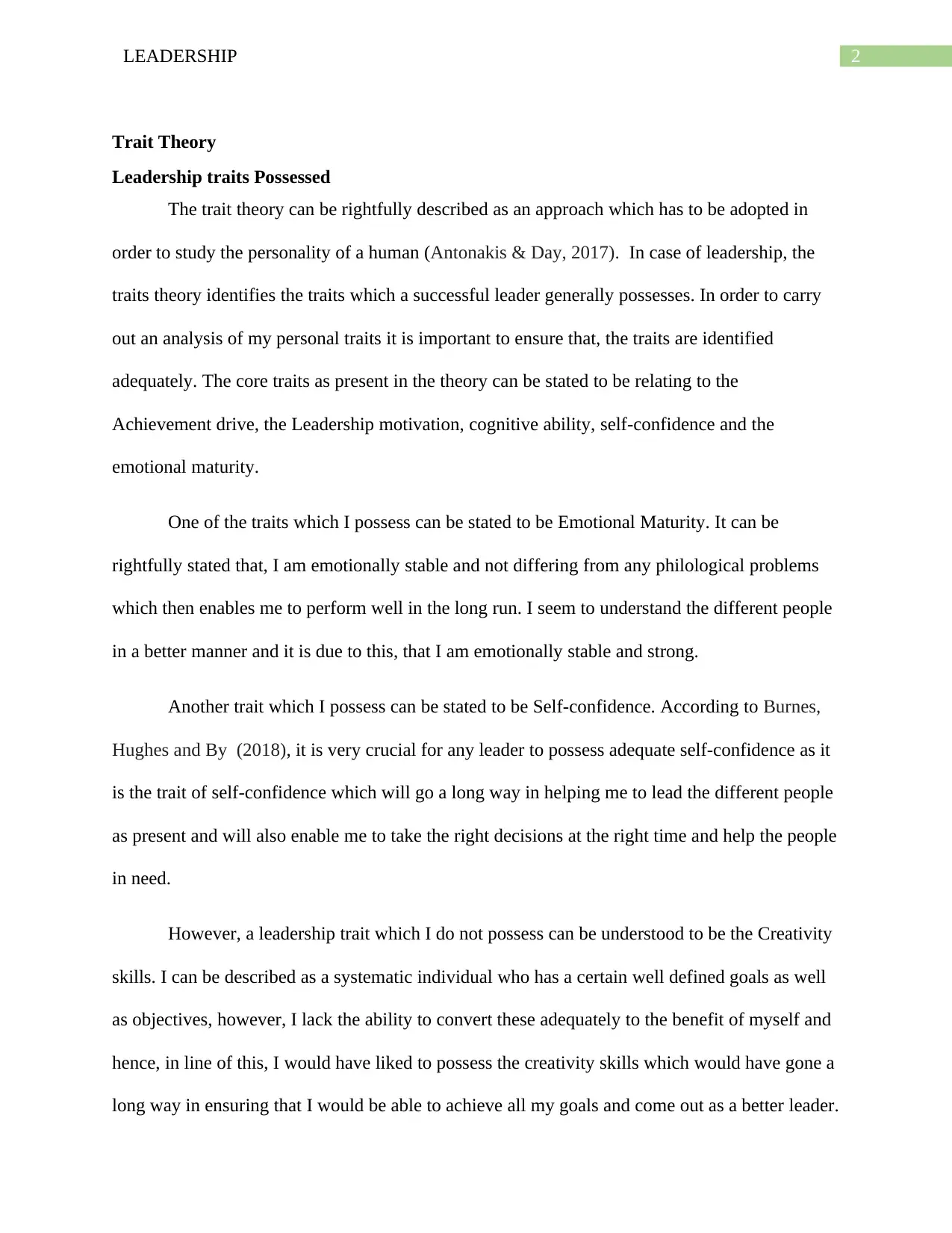
2LEADERSHIP
Trait Theory
Leadership traits Possessed
The trait theory can be rightfully described as an approach which has to be adopted in
order to study the personality of a human (Antonakis & Day, 2017). In case of leadership, the
traits theory identifies the traits which a successful leader generally possesses. In order to carry
out an analysis of my personal traits it is important to ensure that, the traits are identified
adequately. The core traits as present in the theory can be stated to be relating to the
Achievement drive, the Leadership motivation, cognitive ability, self-confidence and the
emotional maturity.
One of the traits which I possess can be stated to be Emotional Maturity. It can be
rightfully stated that, I am emotionally stable and not differing from any philological problems
which then enables me to perform well in the long run. I seem to understand the different people
in a better manner and it is due to this, that I am emotionally stable and strong.
Another trait which I possess can be stated to be Self-confidence. According to Burnes,
Hughes and By (2018), it is very crucial for any leader to possess adequate self-confidence as it
is the trait of self-confidence which will go a long way in helping me to lead the different people
as present and will also enable me to take the right decisions at the right time and help the people
in need.
However, a leadership trait which I do not possess can be understood to be the Creativity
skills. I can be described as a systematic individual who has a certain well defined goals as well
as objectives, however, I lack the ability to convert these adequately to the benefit of myself and
hence, in line of this, I would have liked to possess the creativity skills which would have gone a
long way in ensuring that I would be able to achieve all my goals and come out as a better leader.
Trait Theory
Leadership traits Possessed
The trait theory can be rightfully described as an approach which has to be adopted in
order to study the personality of a human (Antonakis & Day, 2017). In case of leadership, the
traits theory identifies the traits which a successful leader generally possesses. In order to carry
out an analysis of my personal traits it is important to ensure that, the traits are identified
adequately. The core traits as present in the theory can be stated to be relating to the
Achievement drive, the Leadership motivation, cognitive ability, self-confidence and the
emotional maturity.
One of the traits which I possess can be stated to be Emotional Maturity. It can be
rightfully stated that, I am emotionally stable and not differing from any philological problems
which then enables me to perform well in the long run. I seem to understand the different people
in a better manner and it is due to this, that I am emotionally stable and strong.
Another trait which I possess can be stated to be Self-confidence. According to Burnes,
Hughes and By (2018), it is very crucial for any leader to possess adequate self-confidence as it
is the trait of self-confidence which will go a long way in helping me to lead the different people
as present and will also enable me to take the right decisions at the right time and help the people
in need.
However, a leadership trait which I do not possess can be understood to be the Creativity
skills. I can be described as a systematic individual who has a certain well defined goals as well
as objectives, however, I lack the ability to convert these adequately to the benefit of myself and
hence, in line of this, I would have liked to possess the creativity skills which would have gone a
long way in ensuring that I would be able to achieve all my goals and come out as a better leader.
⊘ This is a preview!⊘
Do you want full access?
Subscribe today to unlock all pages.

Trusted by 1+ million students worldwide
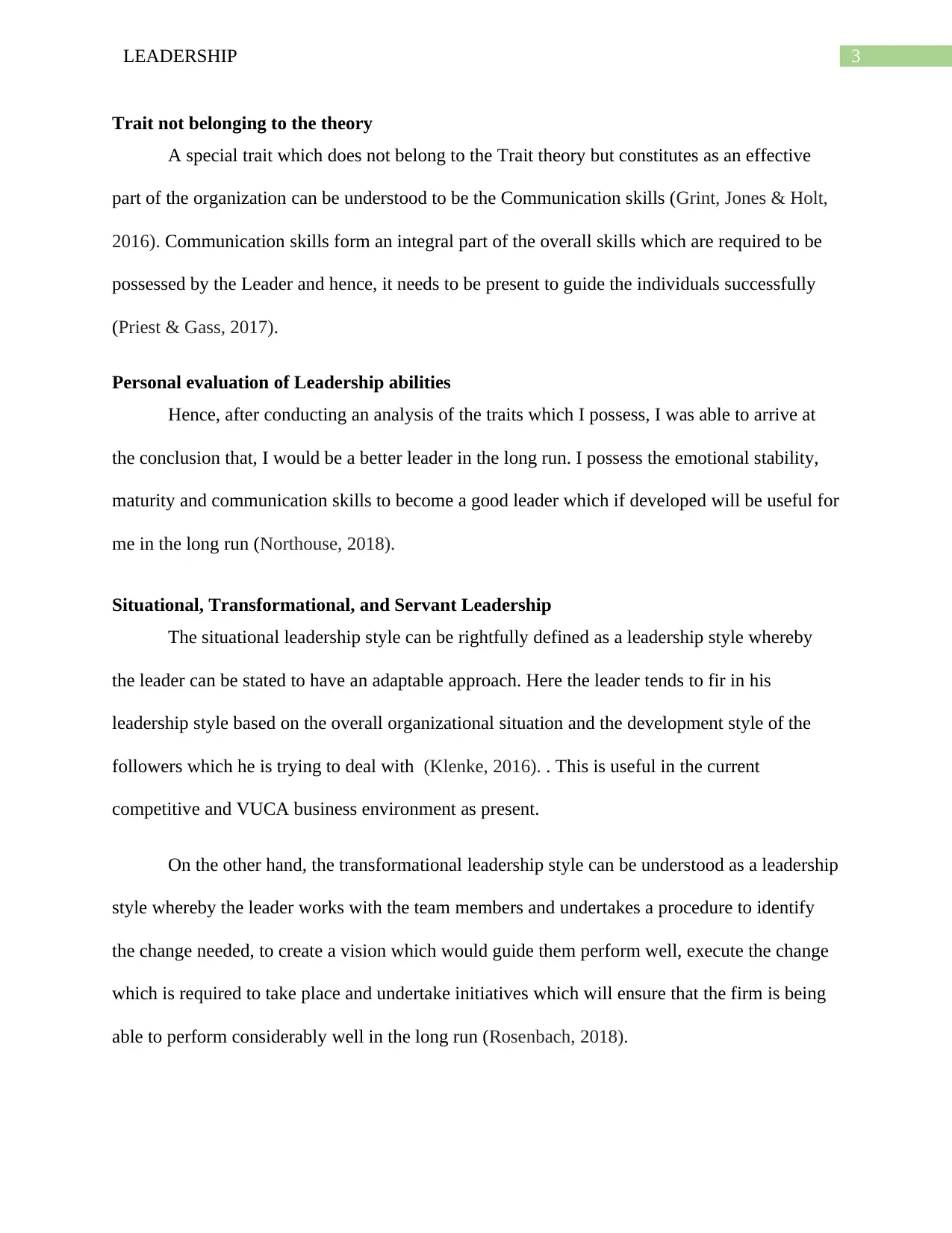
3LEADERSHIP
Trait not belonging to the theory
A special trait which does not belong to the Trait theory but constitutes as an effective
part of the organization can be understood to be the Communication skills (Grint, Jones & Holt,
2016). Communication skills form an integral part of the overall skills which are required to be
possessed by the Leader and hence, it needs to be present to guide the individuals successfully
(Priest & Gass, 2017).
Personal evaluation of Leadership abilities
Hence, after conducting an analysis of the traits which I possess, I was able to arrive at
the conclusion that, I would be a better leader in the long run. I possess the emotional stability,
maturity and communication skills to become a good leader which if developed will be useful for
me in the long run (Northouse, 2018).
Situational, Transformational, and Servant Leadership
The situational leadership style can be rightfully defined as a leadership style whereby
the leader can be stated to have an adaptable approach. Here the leader tends to fir in his
leadership style based on the overall organizational situation and the development style of the
followers which he is trying to deal with (Klenke, 2016). . This is useful in the current
competitive and VUCA business environment as present.
On the other hand, the transformational leadership style can be understood as a leadership
style whereby the leader works with the team members and undertakes a procedure to identify
the change needed, to create a vision which would guide them perform well, execute the change
which is required to take place and undertake initiatives which will ensure that the firm is being
able to perform considerably well in the long run (Rosenbach, 2018).
Trait not belonging to the theory
A special trait which does not belong to the Trait theory but constitutes as an effective
part of the organization can be understood to be the Communication skills (Grint, Jones & Holt,
2016). Communication skills form an integral part of the overall skills which are required to be
possessed by the Leader and hence, it needs to be present to guide the individuals successfully
(Priest & Gass, 2017).
Personal evaluation of Leadership abilities
Hence, after conducting an analysis of the traits which I possess, I was able to arrive at
the conclusion that, I would be a better leader in the long run. I possess the emotional stability,
maturity and communication skills to become a good leader which if developed will be useful for
me in the long run (Northouse, 2018).
Situational, Transformational, and Servant Leadership
The situational leadership style can be rightfully defined as a leadership style whereby
the leader can be stated to have an adaptable approach. Here the leader tends to fir in his
leadership style based on the overall organizational situation and the development style of the
followers which he is trying to deal with (Klenke, 2016). . This is useful in the current
competitive and VUCA business environment as present.
On the other hand, the transformational leadership style can be understood as a leadership
style whereby the leader works with the team members and undertakes a procedure to identify
the change needed, to create a vision which would guide them perform well, execute the change
which is required to take place and undertake initiatives which will ensure that the firm is being
able to perform considerably well in the long run (Rosenbach, 2018).
Paraphrase This Document
Need a fresh take? Get an instant paraphrase of this document with our AI Paraphraser
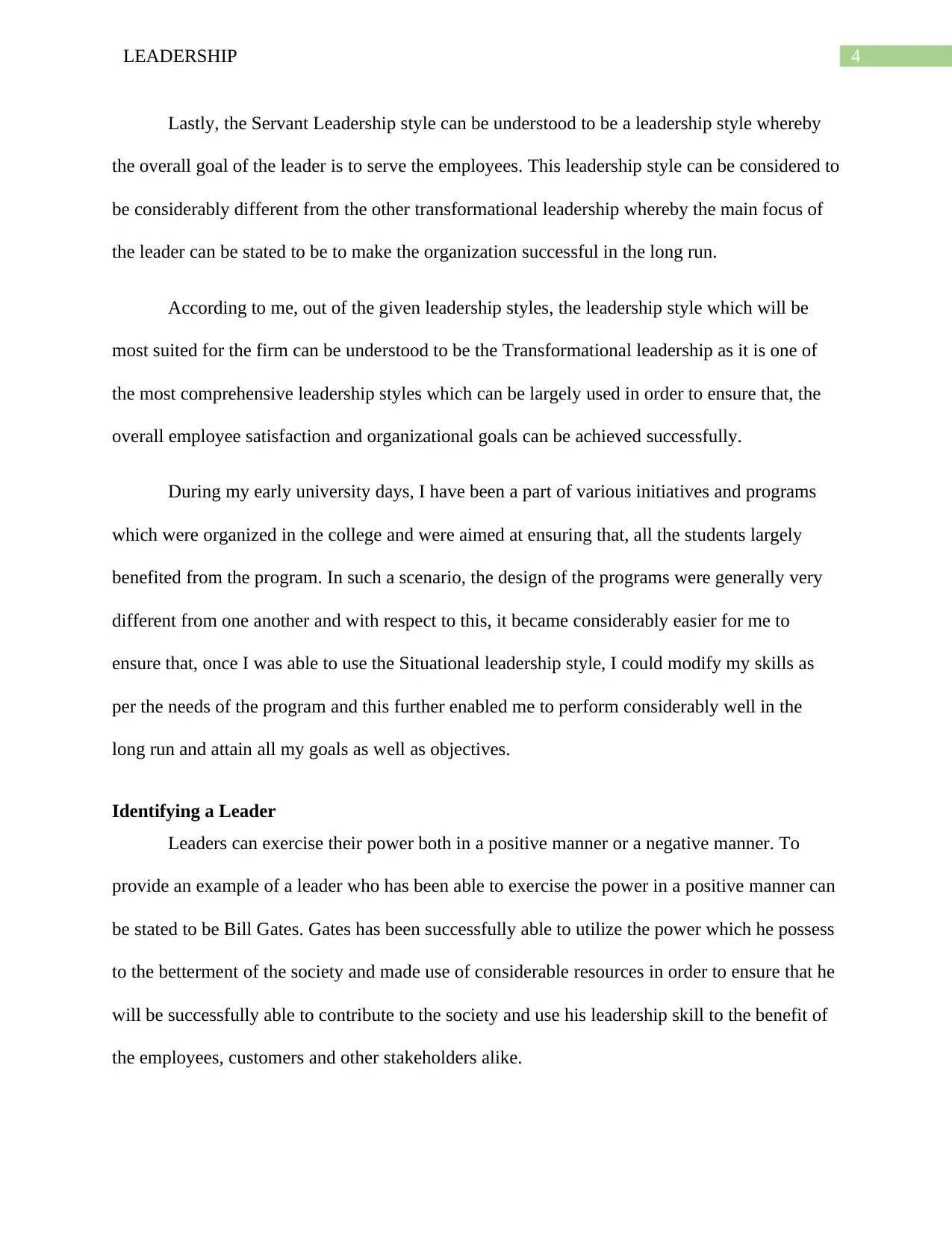
4LEADERSHIP
Lastly, the Servant Leadership style can be understood to be a leadership style whereby
the overall goal of the leader is to serve the employees. This leadership style can be considered to
be considerably different from the other transformational leadership whereby the main focus of
the leader can be stated to be to make the organization successful in the long run.
According to me, out of the given leadership styles, the leadership style which will be
most suited for the firm can be understood to be the Transformational leadership as it is one of
the most comprehensive leadership styles which can be largely used in order to ensure that, the
overall employee satisfaction and organizational goals can be achieved successfully.
During my early university days, I have been a part of various initiatives and programs
which were organized in the college and were aimed at ensuring that, all the students largely
benefited from the program. In such a scenario, the design of the programs were generally very
different from one another and with respect to this, it became considerably easier for me to
ensure that, once I was able to use the Situational leadership style, I could modify my skills as
per the needs of the program and this further enabled me to perform considerably well in the
long run and attain all my goals as well as objectives.
Identifying a Leader
Leaders can exercise their power both in a positive manner or a negative manner. To
provide an example of a leader who has been able to exercise the power in a positive manner can
be stated to be Bill Gates. Gates has been successfully able to utilize the power which he possess
to the betterment of the society and made use of considerable resources in order to ensure that he
will be successfully able to contribute to the society and use his leadership skill to the benefit of
the employees, customers and other stakeholders alike.
Lastly, the Servant Leadership style can be understood to be a leadership style whereby
the overall goal of the leader is to serve the employees. This leadership style can be considered to
be considerably different from the other transformational leadership whereby the main focus of
the leader can be stated to be to make the organization successful in the long run.
According to me, out of the given leadership styles, the leadership style which will be
most suited for the firm can be understood to be the Transformational leadership as it is one of
the most comprehensive leadership styles which can be largely used in order to ensure that, the
overall employee satisfaction and organizational goals can be achieved successfully.
During my early university days, I have been a part of various initiatives and programs
which were organized in the college and were aimed at ensuring that, all the students largely
benefited from the program. In such a scenario, the design of the programs were generally very
different from one another and with respect to this, it became considerably easier for me to
ensure that, once I was able to use the Situational leadership style, I could modify my skills as
per the needs of the program and this further enabled me to perform considerably well in the
long run and attain all my goals as well as objectives.
Identifying a Leader
Leaders can exercise their power both in a positive manner or a negative manner. To
provide an example of a leader who has been able to exercise the power in a positive manner can
be stated to be Bill Gates. Gates has been successfully able to utilize the power which he possess
to the betterment of the society and made use of considerable resources in order to ensure that he
will be successfully able to contribute to the society and use his leadership skill to the benefit of
the employees, customers and other stakeholders alike.
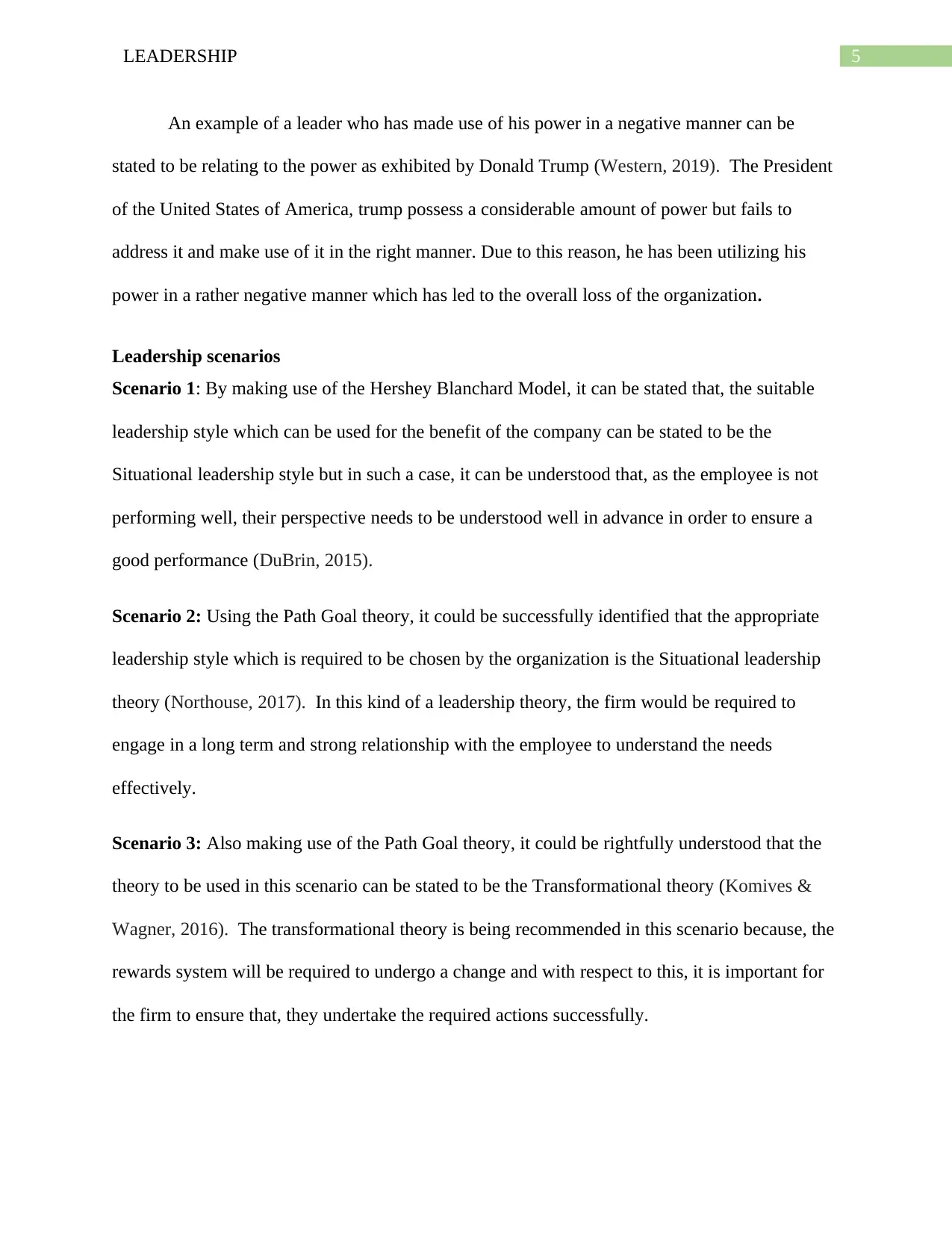
5LEADERSHIP
An example of a leader who has made use of his power in a negative manner can be
stated to be relating to the power as exhibited by Donald Trump (Western, 2019). The President
of the United States of America, trump possess a considerable amount of power but fails to
address it and make use of it in the right manner. Due to this reason, he has been utilizing his
power in a rather negative manner which has led to the overall loss of the organization.
Leadership scenarios
Scenario 1: By making use of the Hershey Blanchard Model, it can be stated that, the suitable
leadership style which can be used for the benefit of the company can be stated to be the
Situational leadership style but in such a case, it can be understood that, as the employee is not
performing well, their perspective needs to be understood well in advance in order to ensure a
good performance (DuBrin, 2015).
Scenario 2: Using the Path Goal theory, it could be successfully identified that the appropriate
leadership style which is required to be chosen by the organization is the Situational leadership
theory (Northouse, 2017). In this kind of a leadership theory, the firm would be required to
engage in a long term and strong relationship with the employee to understand the needs
effectively.
Scenario 3: Also making use of the Path Goal theory, it could be rightfully understood that the
theory to be used in this scenario can be stated to be the Transformational theory (Komives &
Wagner, 2016). The transformational theory is being recommended in this scenario because, the
rewards system will be required to undergo a change and with respect to this, it is important for
the firm to ensure that, they undertake the required actions successfully.
An example of a leader who has made use of his power in a negative manner can be
stated to be relating to the power as exhibited by Donald Trump (Western, 2019). The President
of the United States of America, trump possess a considerable amount of power but fails to
address it and make use of it in the right manner. Due to this reason, he has been utilizing his
power in a rather negative manner which has led to the overall loss of the organization.
Leadership scenarios
Scenario 1: By making use of the Hershey Blanchard Model, it can be stated that, the suitable
leadership style which can be used for the benefit of the company can be stated to be the
Situational leadership style but in such a case, it can be understood that, as the employee is not
performing well, their perspective needs to be understood well in advance in order to ensure a
good performance (DuBrin, 2015).
Scenario 2: Using the Path Goal theory, it could be successfully identified that the appropriate
leadership style which is required to be chosen by the organization is the Situational leadership
theory (Northouse, 2017). In this kind of a leadership theory, the firm would be required to
engage in a long term and strong relationship with the employee to understand the needs
effectively.
Scenario 3: Also making use of the Path Goal theory, it could be rightfully understood that the
theory to be used in this scenario can be stated to be the Transformational theory (Komives &
Wagner, 2016). The transformational theory is being recommended in this scenario because, the
rewards system will be required to undergo a change and with respect to this, it is important for
the firm to ensure that, they undertake the required actions successfully.
⊘ This is a preview!⊘
Do you want full access?
Subscribe today to unlock all pages.

Trusted by 1+ million students worldwide
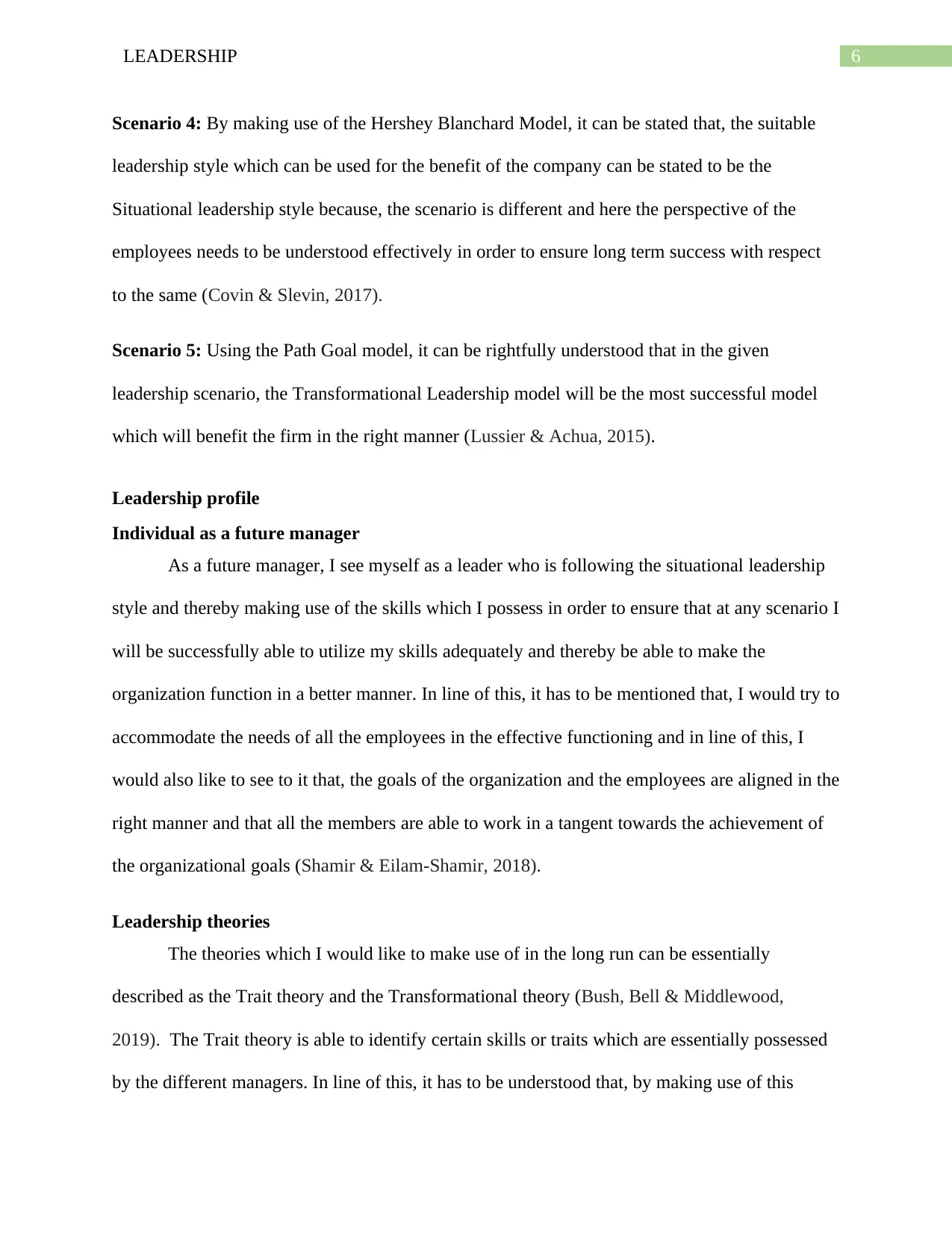
6LEADERSHIP
Scenario 4: By making use of the Hershey Blanchard Model, it can be stated that, the suitable
leadership style which can be used for the benefit of the company can be stated to be the
Situational leadership style because, the scenario is different and here the perspective of the
employees needs to be understood effectively in order to ensure long term success with respect
to the same (Covin & Slevin, 2017).
Scenario 5: Using the Path Goal model, it can be rightfully understood that in the given
leadership scenario, the Transformational Leadership model will be the most successful model
which will benefit the firm in the right manner (Lussier & Achua, 2015).
Leadership profile
Individual as a future manager
As a future manager, I see myself as a leader who is following the situational leadership
style and thereby making use of the skills which I possess in order to ensure that at any scenario I
will be successfully able to utilize my skills adequately and thereby be able to make the
organization function in a better manner. In line of this, it has to be mentioned that, I would try to
accommodate the needs of all the employees in the effective functioning and in line of this, I
would also like to see to it that, the goals of the organization and the employees are aligned in the
right manner and that all the members are able to work in a tangent towards the achievement of
the organizational goals (Shamir & Eilam-Shamir, 2018).
Leadership theories
The theories which I would like to make use of in the long run can be essentially
described as the Trait theory and the Transformational theory (Bush, Bell & Middlewood,
2019). The Trait theory is able to identify certain skills or traits which are essentially possessed
by the different managers. In line of this, it has to be understood that, by making use of this
Scenario 4: By making use of the Hershey Blanchard Model, it can be stated that, the suitable
leadership style which can be used for the benefit of the company can be stated to be the
Situational leadership style because, the scenario is different and here the perspective of the
employees needs to be understood effectively in order to ensure long term success with respect
to the same (Covin & Slevin, 2017).
Scenario 5: Using the Path Goal model, it can be rightfully understood that in the given
leadership scenario, the Transformational Leadership model will be the most successful model
which will benefit the firm in the right manner (Lussier & Achua, 2015).
Leadership profile
Individual as a future manager
As a future manager, I see myself as a leader who is following the situational leadership
style and thereby making use of the skills which I possess in order to ensure that at any scenario I
will be successfully able to utilize my skills adequately and thereby be able to make the
organization function in a better manner. In line of this, it has to be mentioned that, I would try to
accommodate the needs of all the employees in the effective functioning and in line of this, I
would also like to see to it that, the goals of the organization and the employees are aligned in the
right manner and that all the members are able to work in a tangent towards the achievement of
the organizational goals (Shamir & Eilam-Shamir, 2018).
Leadership theories
The theories which I would like to make use of in the long run can be essentially
described as the Trait theory and the Transformational theory (Bush, Bell & Middlewood,
2019). The Trait theory is able to identify certain skills or traits which are essentially possessed
by the different managers. In line of this, it has to be understood that, by making use of this
Paraphrase This Document
Need a fresh take? Get an instant paraphrase of this document with our AI Paraphraser
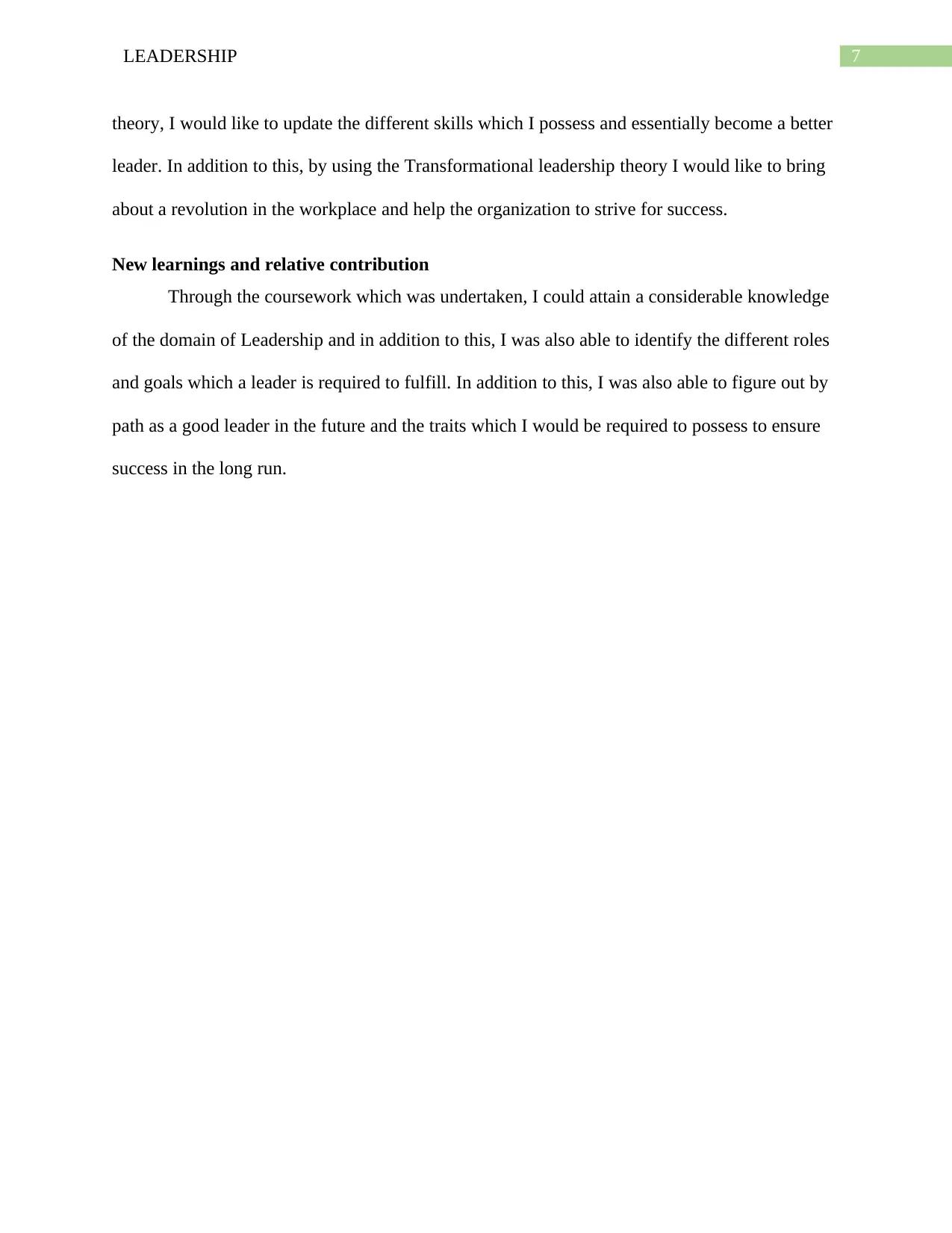
7LEADERSHIP
theory, I would like to update the different skills which I possess and essentially become a better
leader. In addition to this, by using the Transformational leadership theory I would like to bring
about a revolution in the workplace and help the organization to strive for success.
New learnings and relative contribution
Through the coursework which was undertaken, I could attain a considerable knowledge
of the domain of Leadership and in addition to this, I was also able to identify the different roles
and goals which a leader is required to fulfill. In addition to this, I was also able to figure out by
path as a good leader in the future and the traits which I would be required to possess to ensure
success in the long run.
theory, I would like to update the different skills which I possess and essentially become a better
leader. In addition to this, by using the Transformational leadership theory I would like to bring
about a revolution in the workplace and help the organization to strive for success.
New learnings and relative contribution
Through the coursework which was undertaken, I could attain a considerable knowledge
of the domain of Leadership and in addition to this, I was also able to identify the different roles
and goals which a leader is required to fulfill. In addition to this, I was also able to figure out by
path as a good leader in the future and the traits which I would be required to possess to ensure
success in the long run.
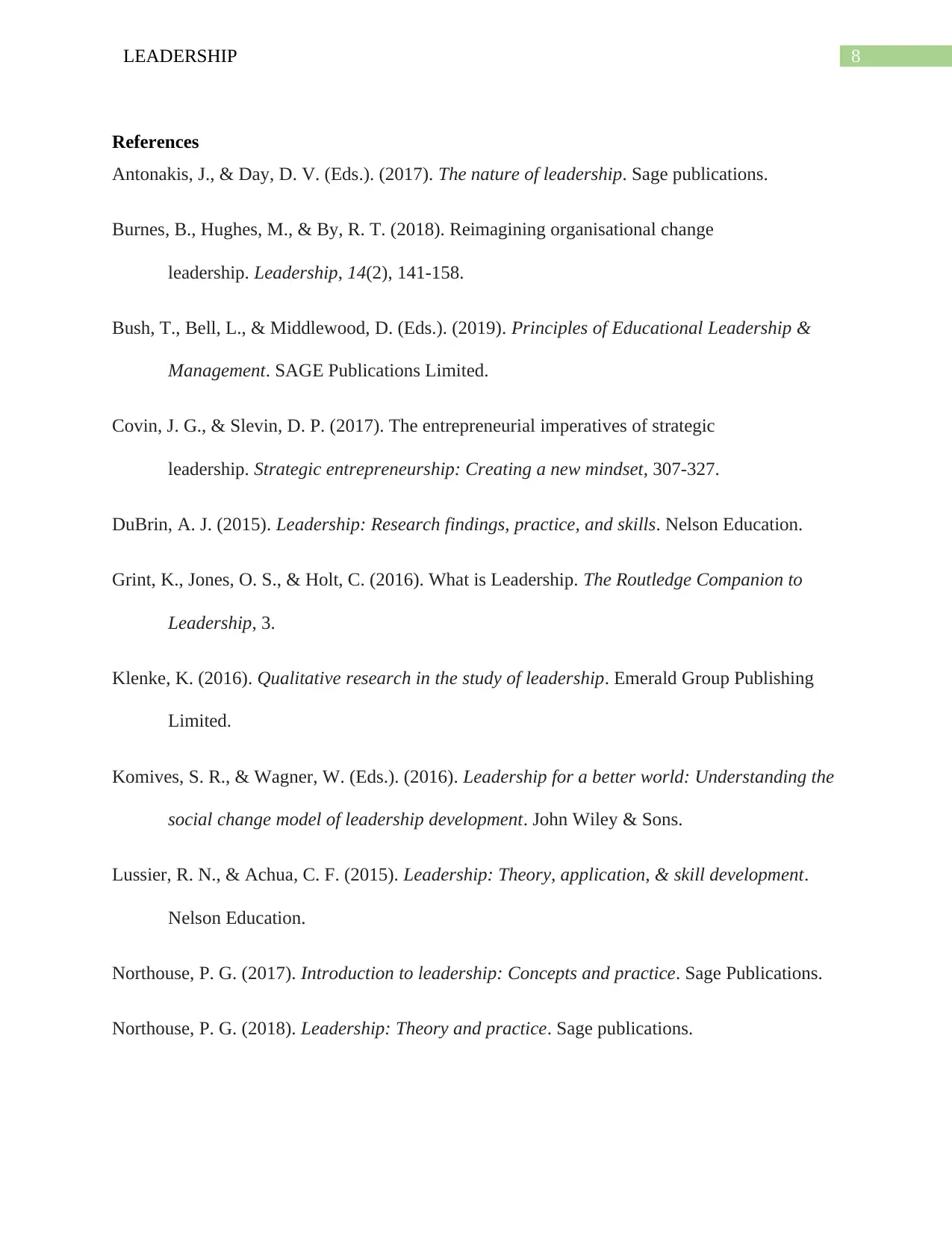
8LEADERSHIP
References
Antonakis, J., & Day, D. V. (Eds.). (2017). The nature of leadership. Sage publications.
Burnes, B., Hughes, M., & By, R. T. (2018). Reimagining organisational change
leadership. Leadership, 14(2), 141-158.
Bush, T., Bell, L., & Middlewood, D. (Eds.). (2019). Principles of Educational Leadership &
Management. SAGE Publications Limited.
Covin, J. G., & Slevin, D. P. (2017). The entrepreneurial imperatives of strategic
leadership. Strategic entrepreneurship: Creating a new mindset, 307-327.
DuBrin, A. J. (2015). Leadership: Research findings, practice, and skills. Nelson Education.
Grint, K., Jones, O. S., & Holt, C. (2016). What is Leadership. The Routledge Companion to
Leadership, 3.
Klenke, K. (2016). Qualitative research in the study of leadership. Emerald Group Publishing
Limited.
Komives, S. R., & Wagner, W. (Eds.). (2016). Leadership for a better world: Understanding the
social change model of leadership development. John Wiley & Sons.
Lussier, R. N., & Achua, C. F. (2015). Leadership: Theory, application, & skill development.
Nelson Education.
Northouse, P. G. (2017). Introduction to leadership: Concepts and practice. Sage Publications.
Northouse, P. G. (2018). Leadership: Theory and practice. Sage publications.
References
Antonakis, J., & Day, D. V. (Eds.). (2017). The nature of leadership. Sage publications.
Burnes, B., Hughes, M., & By, R. T. (2018). Reimagining organisational change
leadership. Leadership, 14(2), 141-158.
Bush, T., Bell, L., & Middlewood, D. (Eds.). (2019). Principles of Educational Leadership &
Management. SAGE Publications Limited.
Covin, J. G., & Slevin, D. P. (2017). The entrepreneurial imperatives of strategic
leadership. Strategic entrepreneurship: Creating a new mindset, 307-327.
DuBrin, A. J. (2015). Leadership: Research findings, practice, and skills. Nelson Education.
Grint, K., Jones, O. S., & Holt, C. (2016). What is Leadership. The Routledge Companion to
Leadership, 3.
Klenke, K. (2016). Qualitative research in the study of leadership. Emerald Group Publishing
Limited.
Komives, S. R., & Wagner, W. (Eds.). (2016). Leadership for a better world: Understanding the
social change model of leadership development. John Wiley & Sons.
Lussier, R. N., & Achua, C. F. (2015). Leadership: Theory, application, & skill development.
Nelson Education.
Northouse, P. G. (2017). Introduction to leadership: Concepts and practice. Sage Publications.
Northouse, P. G. (2018). Leadership: Theory and practice. Sage publications.
⊘ This is a preview!⊘
Do you want full access?
Subscribe today to unlock all pages.

Trusted by 1+ million students worldwide
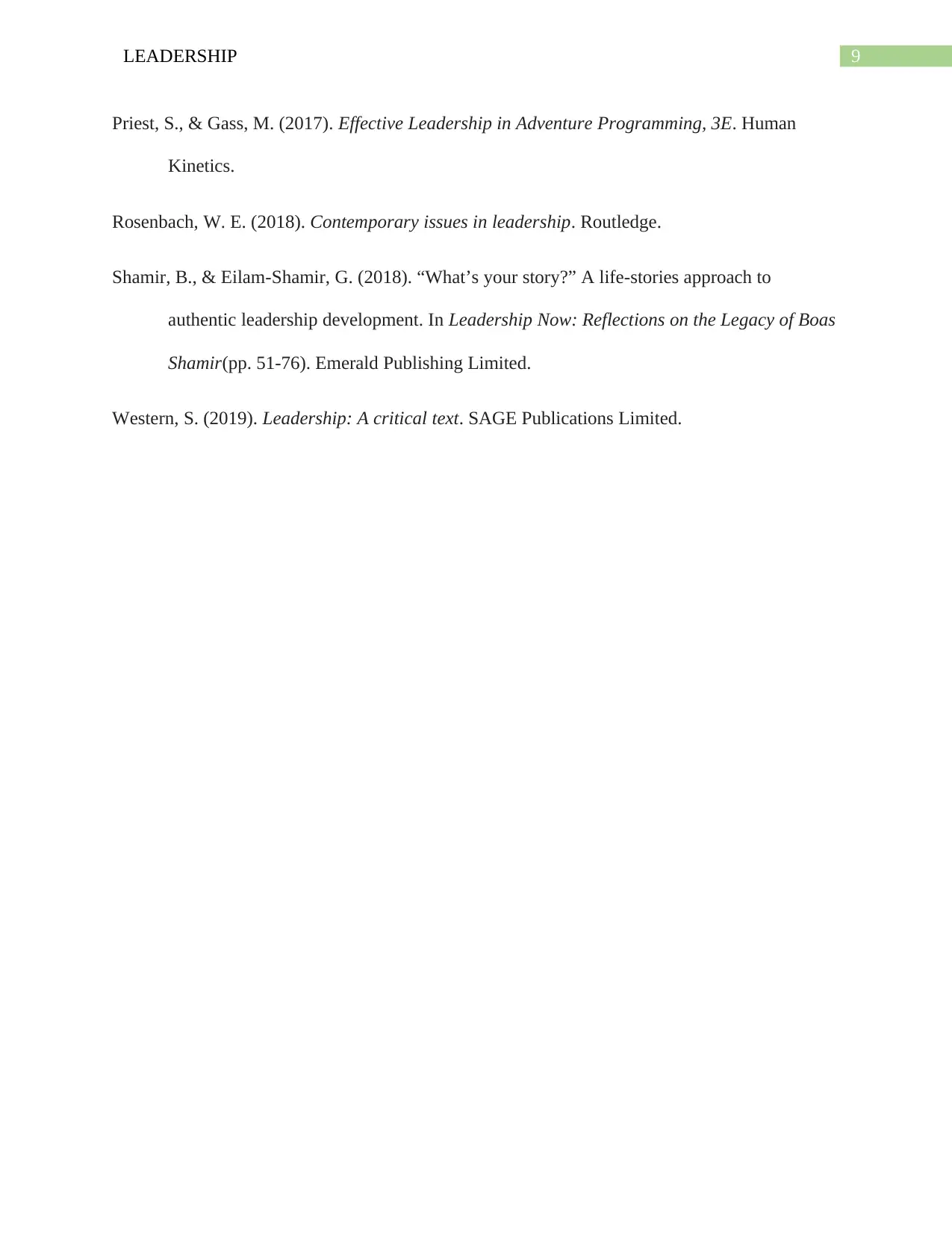
9LEADERSHIP
Priest, S., & Gass, M. (2017). Effective Leadership in Adventure Programming, 3E. Human
Kinetics.
Rosenbach, W. E. (2018). Contemporary issues in leadership. Routledge.
Shamir, B., & Eilam-Shamir, G. (2018). “What’s your story?” A life-stories approach to
authentic leadership development. In Leadership Now: Reflections on the Legacy of Boas
Shamir(pp. 51-76). Emerald Publishing Limited.
Western, S. (2019). Leadership: A critical text. SAGE Publications Limited.
Priest, S., & Gass, M. (2017). Effective Leadership in Adventure Programming, 3E. Human
Kinetics.
Rosenbach, W. E. (2018). Contemporary issues in leadership. Routledge.
Shamir, B., & Eilam-Shamir, G. (2018). “What’s your story?” A life-stories approach to
authentic leadership development. In Leadership Now: Reflections on the Legacy of Boas
Shamir(pp. 51-76). Emerald Publishing Limited.
Western, S. (2019). Leadership: A critical text. SAGE Publications Limited.
1 out of 10
Related Documents
Your All-in-One AI-Powered Toolkit for Academic Success.
+13062052269
info@desklib.com
Available 24*7 on WhatsApp / Email
![[object Object]](/_next/static/media/star-bottom.7253800d.svg)
Unlock your academic potential
Copyright © 2020–2025 A2Z Services. All Rights Reserved. Developed and managed by ZUCOL.



